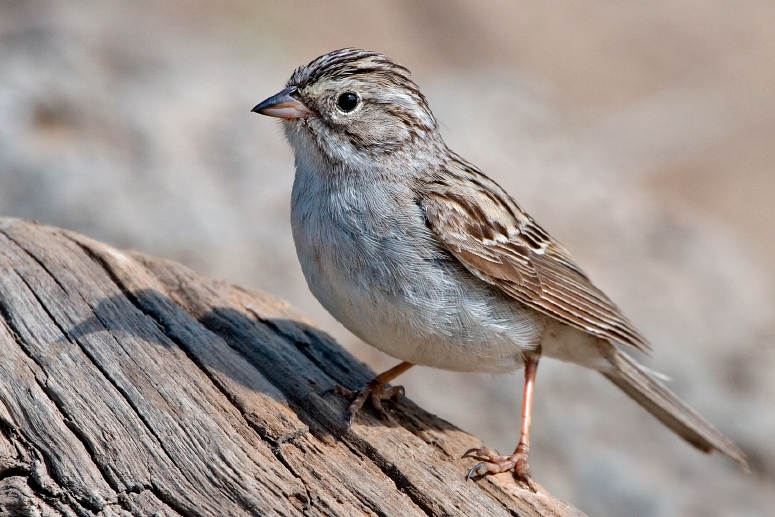- Brewer's Sparrow
Taxobox
name = Brewer's Sparrow

image_width = 240px
image_caption = Adult "S. b. breweri" inDeschutes National Forest ,Oregon
status = LC
status_system = IUCN3.1
regnum =Animal ia
phylum =Chordata
classis =Aves
ordo =Passeriformes
familia =Emberizidae
genus = "Spizella "
species = "S. breweri"
species_authority = (Cassin,1856 )
subspecies = "S. b. breweri"
trinomial = "Spizella breweri breweri"
trinomial_authority = (Cassin, 1856)Brewer's Sparrow, "Spizella breweri", is a small, slim
species ofAmerican sparrow in the familyEmberizidae . This bird was named after the ornithologistThomas Mayo Brewer .Description and systematics
Adults have grey-brown backs and brown crowns, both with dark streaks, and a pale eye-ring. Their wings are brown with light wing bars and the underparts are pale grey. Their bill is pale with a dark tip and they have a long notched tail. They are similar in appearance to the
Clay-colored Sparrow ("S. pallida") but do not have a pale stripe on the crown or grey neck patch.The male sings to defend a nesting territory. The song is a long varied mix of notes and trills. Males have 2 distinct types of songs - classified as short and long songs.
There are two distinct
subspecies :
* Brewer's Sparrow proper, "Spizella breweri breweri":Found in brushy areas, especially withsagebrush , in southern parts of westernCanada and in the westernUnited States .
*Timberline Sparrow , "Spizella breweri taverneri":Found in thicketed areas around thetree line in theRockies of northernBritish Columbia , the southernYukon and southeasternAlaska . These birds are somewhat darker and larger than the southern subspecies; some consider this to be a separate species.Ecology and status
These birds migrate to the
southwestern United States south to centralMexico . These birds forage primarily in shrubs or in low vegetation, but also on the ground. They mainly eat insects in summer with seeds becoming a more important part of the diet at other times of the year. They usually forage in flocks outside of the breeding season, sometimes with other sparrows. The female typically lays 3 to 4 eggs (up to 5) in a cup nest in low shrubs.Brewer's Sparrow has decreased in some parts of their range. Causes are not well understood, but it is suspected that the decline is due at least in part to destruction of sagebrush habitat. Additional information on resource use and limitation during the wintering season is desperately needed. When the Timberline Sparrow was still considered a good species, Brewer's Sparrow was clssified as
Near threatened by theIUCN [BLI (2004)] . However, as only entire species are evaluated for theIUCN Red List , following the merger the entire population of "S. breweri" is classified as Species ofLeast Concern [BLI (2008a,b)] .Footnotes
References
*
* (2008a) [http://www.birdlife.org/datazone/species/index.html?action=SpcHTMDetails.asp&sid=32364&m=0 Brewer's Sparrow Species Factsheet] . Retrieved 2008-MAY-26.
* (2008b): [http://www.birdlife.org/action/science/species/global_species_programme/whats_new.html [2008 IUCN Redlist status changes] . Retrieved 2008-MAY-23.External links
* [http://www.npwrc.usgs.gov/resource/literatr/grasbird/brsp/brsp.htm Effects of Management Practices on Brewer's Sparrow] - NPWRC
* [http://www.sdakotabirds.com/species/brewers_sparrow_info.htm Brewer's Sparrow Information] - South Dakota Birds and Birding
* [http://www.mbr-pwrc.usgs.gov/id/framlst/i5620id.html Brewer's Sparrow - "Spizella breweri"] - USGS Patuxent Bird Identification InfoCenter
* [http://vireo.acnatsci.org/search.html?Form=Search&SEARCHBY=Common&KEYWORDS=brewer%27s+sparrow&showwhat=images&AGE=All&SEX=All&ACT=All&Search=Search&VIEW=All&ORIENTATION=All&RESULTS=24 Brewer's Sparrow photo gallery] VIREO
Wikimedia Foundation. 2010.
